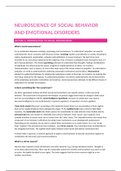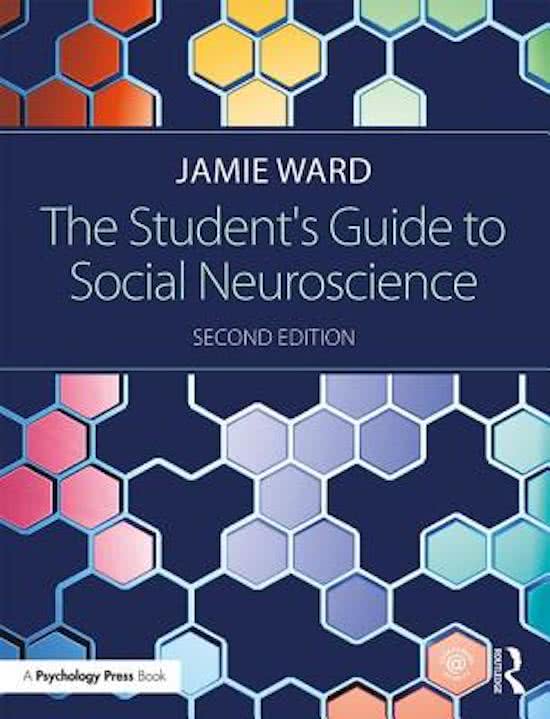NEUROSCIENCE OF SOCIAL BEHAVIOR
AND EMOTIONAL DISORDERS
LECTURE 1: INTRODUCTION TO SOCIAL NEUROSCIENCE
What is social neuroscience?
It is a combination between sociology, psychology and neuroscience. To understand ‘prejudice’ we need to
understand the social, economic and historical context. Sociology studies social behavior or society including its
origins, development, organization, networks and institutions group structures. We lend to be more
favorable to our own group compared to the outgroup. Thus, everyone is prejudiced (not necessarily racist, it’s
part of group-behavior. The (social) psychology attempts to understand how thoughts, feelings and behaviors
of individuals are influenced by the actual, imagined or implied presence of others. For instance,
‘dehumanization’ such as slavery a term that steps away of the actual content of prejudice. To understand a
prejudice, we need to understand the underlying (automatic) motivations and emotions. Neuroscience
attempts to understand behavior by studying the underlying circuitry in the brain. For instance, by studying the
‘love-drug’ oxytocin for the ingroup. To understand prejudice, we need to understand the neural mechanisms
of the underlying (automatic) motivations and emotions. Social neuroscience attempts to link different levels of
explanation for example for prejudice.
Is there something like ‘the social brain’?
Are there specialized routines and brain structures that perform very specific actions, in this case social
behavior. The social brain is not general non-modular. In general: bigger brains lead to changes in both social
and non-social intelligence OR the social intelligence hypothesis: pressure to outwit peers may lead to
increased intelligence in non-social domains (= general cognition is a byproduct of social cognition).
Triune brain model (MacLean): according to this model the human brain is an accumulation of brain regions
that can be roughly divided in three phylogenetic stages the reptilian brain (sub-cortex) for fight-flight
reactions, the mammalian brain (the limbic system) for emotionality to make behavior more flexible and the
primate brain (the neo-cortex) for rationality and control of behavior. Each ‘newer’ layer supports more
complex functions an exerts some sort of control over the ‘older’ layers. This crosstalk however also means that
a large part of our behavior is still driven by similar brain mechanisms as our phylogenetic predecessors.
Depending on the situations we are able to control these mechanisms to a certain extent. So, is our ‘social
brain’ modular? The primate brain (non-modular)… but mirror neurons. The mammalian brain (module-like) in
the amygdala and insula. The reptilian brain (quite modular) small nuclei with distinct (non)social roles.
A mixed mode: in general, a network approach to apply to social behavior to describe social brain regions (in
combination the hormones and neurotransmitters).
What is a mirror neuron?
Neurons that respond to both self-behavior and other-behavior (e.g.) during intentional actions. Thought to
serve observational learning. There may be comparable systems for emotion and sensations (e.g. pain) as well
as action. Not tightly localized to one region. The book suggests that the mirror neurons might be a non-
modular social brain.
,Methods of social neuroscience: psychological methods
Psychological methods can be distinguished in three categories: subjective, observational and performance
measures.
Subjective measures: emotional experiences through questionnaires or interviews/personality
questionnaires for different kind of ‘problems’ (such as anxiety). Questionnaires are useful as control
variable or for correlation with other measure or as comparison for different studies.
Observational measures: where behavior of a participant will be counted, the participant is usually a
infant or animal. This can be done by a recording (camera is blinded, to create higher inter-rater
reliability). Also, eye-tracking is a observational measure very structured.
Performance measures: a measure of speed and accuracy in the speed-accuracy trade-off. Very stable
measure but restricted ‘real’-behavior. Also, IQ-test, recognition tests and selective attention tasks
(such as the stroop task: interference of the word emotional stroop: interference of emotion
facial fear stroop interference of expression).
These measures are not extremely fancy, but essential. Biological measures without additional information
make no sense in social neuroscience.
Methods of social neuroscience: psychophysiology measures
Psychophysiology measures bodily responses to emotions or arousal controlled by the brain through the spinal
cord. We have two nervous systems: parasympathic and sympathic nervous system.
Skin conductance respondence (SCR) measures sweats gland related to sympathic arousal. Can occur
in absence of conscious perception, with a signal peak 1-5 seconds after the emotion events. It can
measure unconscious perception to emotional stimuli.
Heart rate/respiration measures deceleration and acceleration or heart rate variability (HRV) in rest
your HRV is more variable to prepare for action (in action of the parasympathic system)
Electromyography (EMG) are measures of the potential between pairs of close electrodes of muscle
activity. For instance, in mimicking facial expression for affective empathy.
o Startle potentiation with the eye blink startle potentiation very reflexive and out of
control. Startle is stronger in a dangerous situation.
Methods of social neuroscience: brain imaging methods
All neurons have same basic structure: cell body, axon and dendrites. De dendrites are connected to axons of
other neurons and receive information of potentials differences. The axon creates action potentials by
changing the potential to create a message (there is a threshold). Potential differences can be measured by
single-cell recordings. With these recordings there will place a small electrode into an axon which will
record neural activity, number of action potentials per second without stimulation it.
Electroencephalography (EEG) picks up neural activity of a large number of cells. This is possible due to the
column-like organization of the cortex, but it’s also limited to cortex activation. EEG can be used in frequency
bands teasing apart signals out of one big EEG signal. For instance, delta-waves (1-4Hz) for motivational
systems: bottom-up drive of beta-waves (12-30Hz) for cortex and top-down modulation. EEG can also be used
with Event-Related Potentials (ERP) where an EEG signal is averaged over many trials synchronized with some
events. The resulting ERP is a series of positive and negative peaks which tells you something about the
amplitude, place and timing. For instance, the N170 peak for face activity in the fusiform face area for research
on emotion, visibility and familiarity. Disadvantages of ERP: however, it is directly related neural activity with
great temporal resolution, it is also derived from multiple sources I the brain at the same time and therefore it
has a very poor spatial resolution.
, Magnetic resonance imaging (MRI) relies on the alignment of water molecules. Molecules are first aligned in a
strong magnet and next there will be a radio transmitter on a region and then turn it off so you can measure
the re-alignment of water molecules in a tissue of the activated region.
Functional MRI (fMRI) builds on the idea of hemodynamic method and that neural activity consumes oxygen
and thus needs blood. fMRI measures the blood oxygenation; oxygen slows re-alignment of water molecules.
It’s a very non-invasive technique compared to PET (where a radioactive substance is used inside the body).
What does it mean if a brain region is active? A region is ‘’active’’ if it shows a greater response in one
condition relative to another. You’ll always need a control condition in fMRI. If inappropriate conditions the
activity will be meaningless (junk in, junk out). fMRI does have a good spatial resolution (especially compared
to EEG). The drawback is that fMRI has poor temporal resolution because it uses the BOLD response: Blood
Oxygen Level Dependent contrast hemodynamic response functions which makes the resolution about 6
seconds. If trials in your design are close together this will make it harder to distinguish each hemodynamic
response to each trial. Thinking about timing in your study design is important.
Diffusion tensor imaging (DTI) is used to map the white matter microstructure (white matter = meyline around
the axons). Brain areas are connected (=communication bundles) together by bundles of axons and these can
be measured with DTI. DTI measures again the diffusion of water molecules and the movement is different
inside the white matter compared to the grey matter. Water molecules are more restricted in white matter. DTI
is also MRI but multiple angles and time-points. The spatial resolution is quite good, but we can only measure
big fibers.
Using MRI, we can measure:
- Brain structure (MRI)
- Brain connections (DTI)
- Activation location (fMRI)
If we also want timing of activation, we can use event related potentials (EEG-ERP) only in the cortex.
Subcortical brain imaging with high temporal resolution is currently not available. Deep brain electrodes; highly
invasive, only applicable in combination with specialized treatments.
Methods of social neuroscience: lesion and disruption of function
Lesion methods are based on the famous case of Phineas Gage (1848). Which lesion methods you use reversed
engineering: infer the function of a region (or cognitive mechanism) by removing it and measuring the effect on
the rest of the system. This is usually how animal research works for instance, chemo or optogenetics. Human
models are based on accidents, stroke, lobectomy, genetic disorders (such as Urbach-Wiethe disease) or
Transcranial Magnetic Stimulation.
Transcranial Magnetic Stimulation (TMS) is performed using a coil though which you can send out an electric
current to create a magnetic field and this evokes action potentials. This disrupts the cognitive function that
they may be doing at that point of time. The advantages of TMS over organic lesion is that they are quite easy,
but you can’t reach the deep brain regions. However, it is reversible and moveable. You can investigate the
time-course of cognition (effects are brief and precise). Disadvantage of TMS: not a good placebo condition
because you can feel the TMS. Solution (partly) different time windows, different spatial location, different
task or different stimuli as a control.






